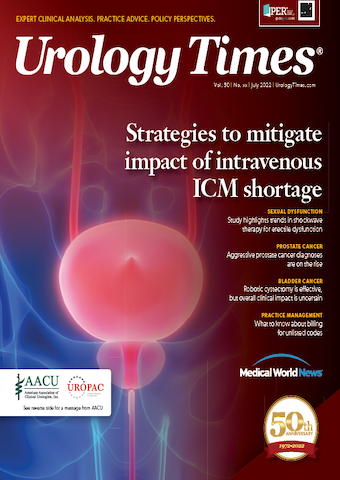Publication
Article
Urology Times Journal
Ethnic differences in men undergoing reproductive urology evaluation
Author(s):
"As clinicians, we must better understand how race plays a role in fertility therapy," writes Mary K. Samplaski, MD.
Mary K. Samplaski, MD

Although up to 50% of infertility cases have a male factor component,1 there are scant data on what factors are associated with the male partner undergoing a fertility evaluation. Racial differences in fertility care have been identified, most from the National Survey of Family Growth (NSFG), which evaluates the American civilian population. Data from the 2011 to 2017 NSFG found that 9.5% of men seeking infertile services were Black, 69.1% were White, 16.1% were Hispanic, and 5.3% identified as “other.”2,3 Black women have been shown to have a 1.45 times greater adjusted prevalence of infertility compared with White women.4 Lastly, Black men are more likely to have their female partner undergo testing first, as compared with White men.5
In a multi-institutional survey-based publication of men in North America undergoing fertility evaluation by a reproductive urologist, several key racial differences were identified.6 The racial breakdown of 6462 men was: 51% White, 20% Asian/Indo-Canadian/Indo-American, 6% Black, 1% Indian/Native, fewer than 1% Native Hawaiian/Other Pacific Islander, and 21% other.
The following differences were seen:
• White men sought evaluation sooner after initiating paternity attempts (3.5 ± 4.7 years vs 3.8 ± 4.2 years), had older female partners (33.3 ± 4.9 years vs 32.9 ± 5.2 years), and more had undergone vasectomy (8.4% vs 2.9%) vs all other races.
• Black men were older (38.0 ± 8.1 years vs 36.5 ± 7.4 years), sought fertility evaluation after initiating paternity attempts (4.8 ± 5.1 years vs 3.6 ± 4.4 years), fewer had undergone vasectomy (3.3% vs 5.9%), and fewer had partners undergo intrauterine insemination (8.2% vs 12.6%).
• Asian/Indo-Canadian/Indo-American men were younger (36.1 ± 7.2 years vs 36.7 ± 7.6 years), fewer had undergone vasectomy (1.2% vs 6.9%), and more had partners who underwent intrauterine insemination (14.2% vs 11.9%).
• Indian/Native men sought evaluation later (5.1 ± 6.8 years vs 3.6 ± 4.4 years) and more had undergone vasectomy (13.4% vs 5.7%).
With respect to lifestyle factors:
• White men were more likely to be overweight (defined as body mass index [BMI] ≥ 25.0 kg/m2) or obese (as defined by BMI ≥ 30.0 kg/m2) when compared with all other races (74.4% vs 69.5%).
• White men were more likely to drink alcohol (84.7% vs 73.6%).
• White and Indian/Native men were more likely to use marijuana (20.1% vs 13.0% and 28.4% vs 16.5%, respectively).
• White men were more likely to report cocaine use (1.9% vs 1.2%).
• White men were more likely to have used steroids (1.3% vs 0.6%) and exogenous testosterone, as compared with other populations (1.3% vs 0.6%).
This is the first study to demonstrate that men from different racial groups seeking fertility investigation have significantly different characteristics. These observed differences may reflect true biologic or genetic differences, or may result from environmental exposures, lifestyle factors, cultural factors, access to care, systemic racism, or different treatment modalities.
Prior studies show that assisted reproductive technology usage rates among Black, non-Hispanic women are lower than the average US utilization rate7 and White women are more likely to utilize fertility services.8 One of the most clear examples of racial differences on reproductive choices that we identified was in vasectomy rates. Asian/Indo-Canadian/Indo-American and Black subgroups were less likely, whereas White and Indian/Native subgroups were more likely to have had a vasectomy as compared with other races. This is similar to data from the 2002 NSFG, which found that Black and Hispanic men were less likely to rely on vasectomy for contraception, even after accounting for a host of other factors (14.1% of White men, 3.7% of Black men, and 4.5% of Hispanic men had a vasectomy).9
Willingness to undergo medical investigation and therapy may also be affected by social and cultural backgrounds. Black patients have been shown to report lower levels of trust in health care providers when compared with White patients, often related to a history of lower quality interactions with health care providers.10 And although racial differences in patient’s medical care preferences may exist, racial differences in referral patterns and decisions to initiate treatment may remain.11
Racial differences exist for men undergoing fertility evaluation by a reproductive urologist. These differences, such as age, duration of infertility, previous vasectomies, partner age, BMI, lifestyle factors, and previous reproductive outcomes, may be due to a variety of differences between racial groups. As clinicians, we must better understand how race plays a role in fertility therapy. The associations between race, biologic, and societal factors in fertility should guide clinicians as they obtain a history, counsel patients, and expand outreach to underserved populations. Increased awareness is a critical step in addressing inequities and disparities in infertility.
References
1. Louis JF, Thoma ME, Sørensen DN, et al. The prevalence of couple infertility in the United States from a male perspective: evidence from a nationally representative sample. Andrology. 2013;1(5):741-748. doi:10.1111/j.2047-2927.2013.00110.x
2. Hotaling JM, Davenport MT, Eisenberg ML, VanDenEeden SK, Walsh TJ. Men who seek infertility care may not represent the general U.S. population: data from the National Survey of Family Growth. Urology. 2012;79(1):123-127. doi:10.1016/j.urology.2011.09.021
3. Persily J, Stair S, Najari BB. Access to infertility services: characterizing potentially infertile men in the United States with the use of the National Survey for Family Growth. Fertil Steril. 2020;114(1):83-88. doi:10.1016/j.fertnstert.2020.03.005
4. Janitz AE, Peck JD, Craig LB. Racial/ethnic differences in the utilization of infertility services: a focus on American Indian/Alaska natives. Matern Child Health J.2019;23(1):10-18. doi:10.1007/s10995-018-2586-y
5. Sherrod RA, DeCoster J. Male infertility: an exploratory comparison of African American and white men. J Cult Divers. 2011;18(1):29-35.
6. Chen AB, Jarvi KA, Lajkosz K, et al. One size does not fit all: variations by ethnicity in demographic characteristics of men seeking fertility treatment across North America. Fertil Steril.2021;116(5):1287-1294. doi:10.1016/j.fertnstert.2021.06.029
7. Dieke AC, Zhang Y, Kissin DM, Barfield WD, Boulet SL. Disparities in assisted reproductive technology utilization by race and ethnicity, United States, 2014: a commentary. J Womens Health (Larchmt). 2017;26(6):605-608. doi:10.1089/jwh.2017.6467
8. Stephen EH, Chandra A. Use of infertility services in the United States: 1995. Fam Plann Perspect. 2000;32(3):132-137.
9. Eisenberg ML, Lathi RB, Baker VL, Westphal LM, Milki AA, Nangia AK. Frequency of the male infertility evaluation: data from the national survey of family growth. J Urol. 2013;189(3):1030-1034. doi:10.1016/j.juro.2012.08.239
10. Halbert CH, Armstrong K, Gandy OH Jr, Shaker L. Racial differences in trust in health care providers. Arch Intern Med. 2006;166(8):896-901. doi:10.1001/archinte.166.8.896
11. Ayanian JZ, Cleary PD, Weissman JS, Epstein AM. The effect of patients’ preferences on racial differences in access to renal transplantation. N Engl J Med. 1999;341(22):1661-1669. doi:10.1056/NEJM199911253412206

Newsletter
Stay current with the latest urology news and practice-changing insights — sign up now for the essential updates every urologist needs.



























